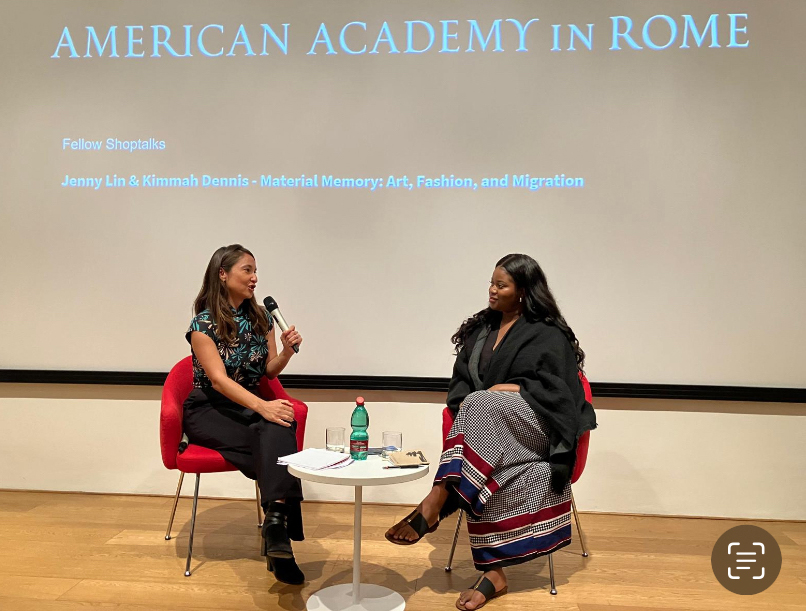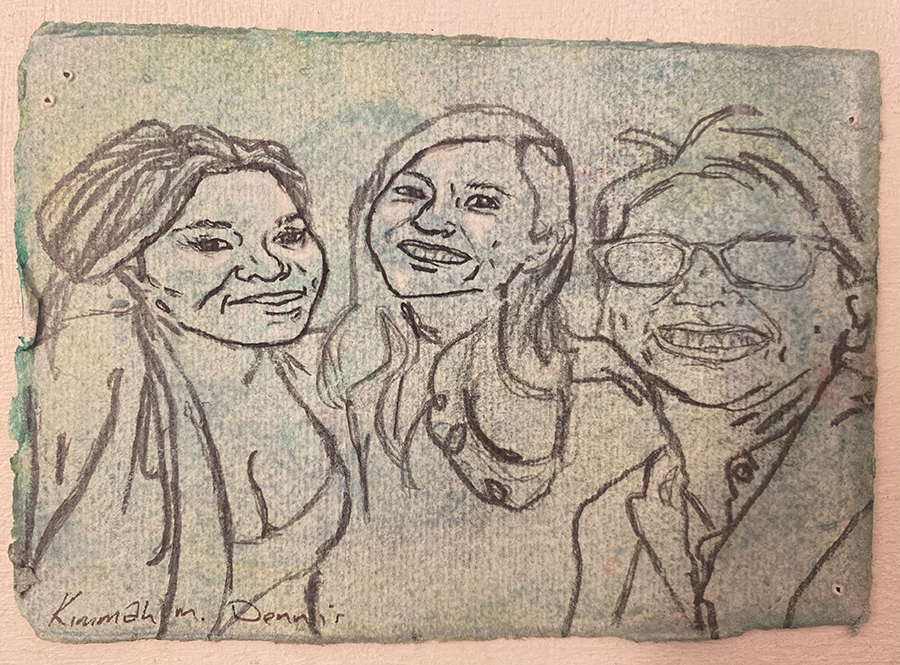Jenny Lin, the 2024–25 Tsao Family Rome Prize Fellow, is an associate professor at the University of Southern California’s Roski School of Art and Design, where her research bridges contemporary art, fashion, and urban culture. At the American Academy in Rome, she is researching and writing a book that traces creative exchanges between China, Italy, and the United States—with particular attention to how artists, designers, and cultural institutions navigate global networks shaped by commerce, migration, and politics.
Lin shares how her project came about, where she has conducted research during her fellowship, and what her favorite vintage clothing market is.
What initially drew you to exploring cross-cultural exchanges in art and fashion across China, Italy, and the United States in your project, and how do they shape your understanding of globalization?
Growing up half-Chinese and half-mixed European American, I developed a lifelong interest in cross-cultural exchanges. The first person I ever interviewed was my paternal grandmother, Shu-in Lin, who immigrated from Wenzhou to Taipei to Gainesville, Florida, and eventually to Silicon Valley, California. I grew fascinated by her stories of adapting to new cultures and awed by her elegant fashion sense. She had dozens of spectacular tailor-made qipao dresses from 1960s Taiwan that I inherited, some of which appear in works by artist collaborators, seen in the exhibition I recently curated, Another Beautiful Country: Moving Images by Chinese American Artists. Inspired by writings by figures like Eileen Chang and films such as Wong Kar-wai’s In the Mood for Love, I’ve often thought about all the stories—of migration and intercultural relations—that those dresses can convey.
My interest in fusions between contemporary art and fashion across China, Italy, and the United States began over a decade ago, while I was living in Shanghai conducting PhD research toward what would become my first book, Above Sea: Contemporary Art, Urban Culture, and the Fashioning of Global Shanghai. During that time, I met several Chinese artists collaborating with European fashion houses to create installations and videos for brands like Dior and Prada. I also found some of the most experimental contemporary Chinese art in galleries attached to foreign retail spaces, as in Bottega Veneta’s gallery on Shanghai’s Bund, or circulated through transnational fashion magazines, such as Vogue Italia. I came to understand these cross-cultural art/fashion exchanges as valuable modes for sharing personal perspectives and hybrid styles that resist exoticizing stereotypes.
You frame these collaborations as part of a “global art-fashion system” linked to initiatives like China’s New Silk Road. How do you see these economic and political strategies influencing creative practices in art and design?
The “global art-fashion system” I’m theorizing has multiple, intertwined facets—from large-scale museum exhibitions sponsored by luxury brands and public institutions to unique collaborations between artisans and artists. I’m interested in the ways economic and political strategies play out in global and localized contexts, as in the phenomenon of Chinese textile workers living in Prato and producing “Made in Italy” clothing. I also look to how artists and designers respond to such phenomena, as with projects that critically unravel nationalist mythologies or pose sustainable alternatives to fast fashion.
Rome’s legacy as a cosmopolitan crossroads makes it an ideal setting for your study. What unique insights have you gained from engaging directly with the city’s cultural and institutional landscapes?
I delight in encountering ancient ruins and historical markers within contemporary landscapes, like the Acquedotto Vergine visible from the lowest level of the Rinascente department store, or the replica of Bocca della Verità that I stumbled upon while visiting a new wave photography exhibition at Museo di Roma in Trastevere. At EUR (Esposizione Universale Roma), a district known for its monumental, Fascist-era architecture, I’ve studied twenty-first-century handbags designed in collaboration with Chinese artisans in the Fendi archive in Palazzo della Civiltà and listened to DJ sets by Manymanybow e Laowai at the opening of an exhibition by contemporary artist Gala Porras-Kim, who reimagined the colonial collections of Museo della Civiltà. Rome’s palimpsestic, kaleidoscopic materializations of the rich mixing of cultures and periods help me ponder and draw together constellations of connections across time and space.

Your work bridges historical reflection with contemporary case studies. How do you balance the archival research on past collaborations with the analysis of current practices in the art-fashion sector?
I quite enjoy balancing research in museums, libraries, and archives with interviews and studio visits. These various strands of my research frequently combine, as during a recent lunch meeting with contemporary art curators Francesco Urbano Ragazzi (current Italian fellows at the American Academy in Rome) at Hangzhou da Sonia, a famed Chinese restaurant in Rome’s Esquilino neighborhood, known to many as the city’s Chinatown. We discussed the curators’ collaborations with fashion brands, including Gucci, in the restaurant owned by the iconic Sonia Zhou, who appeared in a Gucci advertising campaign directed by the brand’s former creative director Alessandro Michele. Hangzhou da Sonia, like so many artists’ studios I’ve visited, stands as a living archive: the restaurant brims with newspaper clippings and photographs of the owner with celebrities and politicians from around the world.
Another time, while researching in Prato, I spent the morning at Centro Pecci, attending a contemporary art conference and meeting with curators, artists, and designers, the afternoon studying magazines, photographs, letters, and ephemera in the museum’s archive, and the evening speaking with Leone Contini, an artist and scholar whose projects center Chinese-Italian relations, over a studio visit and meal in Prato’s Chinatown. Much of my research revolves around food, and shopping of course! I read that the artist Ren Hang, when visiting Rome from Beijing for an exhibition, refused to go to museums and only wanted to vintage shop. I’ve been trying to retrace his sartorial steps, while also frequenting museums.
Where have you most liked working within the Academy?
I enjoy looking through the remarkable books in the Academy library and browsing the awe-inspiring special collections, though my favorite place to read and write is in the Bass Garden. What bliss to sit outside with my laptop on a spring day, surrounded by fluttering flower petals, chirping parakeets, and amazing sounds coming from the studios of fantastic artists and musicians like Rome Prize winners Lex Brown and Jonah Nuoja Luo Haven, all swirling around a grassy knoll where Galileo first demonstrated his telescope to a learned audience in Rome.
What have you seen in the city of Rome that has made a strong impression on you?
Wow—so many things, but here are a few:
- Il Mercatino del Borghetto Flaminio, my favorite vintage clothing market, held every Sunday, rain or shine
- La Città Proibita, a kung fu movie set in present-day Rome, which centers a Chinese woman in search of her sister and revolves around Chinese and Italian restaurants in the Esquilino neighborhood
- A dance party at the Spanish Academy with fabulous DJs
- An art exhibition curated by Maurizio Cattelan at Villa Medici, lit in purple for the occasion’s opening
- Graffiti everywhere, and especially a pink and blue heart on the rocky steps connecting the Academy and Trastevere
How have your interactions with this year’s fellows and residents influenced your work or changed your perspective?
It’s a joy and privilege conversing with fellow Rome prize winners, a truly amazing group of brilliant and talented scholars, artists, musicians, architects, writers, and designers, and with world-renowned residents, who have been so generous with sharing knowledge. Over lunches, dinners, and lectures followed by aperitivos, I’ve connected with scholars of immigration in Italy, contemporary art and design curators, modern transnational fashion icons, and visionary artists and designers who identify as cittadini del mondo (citizens of the world).

Working alongside artists and designers invaluably helps me understand creative and material processes that connect to my research. This fall, I visited Piazza Vittorio Emanuele, an area with a high concentration of immigrants in Rome, with Terra Foundation Affiliated Fellow Kimmah Dennis, who makes paintings and multimedia installations about immigration, cultural displacement, and belonging. Together we spoke with immigrants who had recently made their home in Rome, including people who would figure prominently in artworks Kimmah made while here in residence.
Another fellow Rome Prize winner, Amy Revier, is an artist and weaver, who constructed a loom in her studio and now weaves silk procured in and around Prato. As I’ve been writing about the coming together of Chinese-Italian-US fashion and art, and thinking about silk roads, as well as systems theories and historical figures like Mario Tchou, a groundbreaking Chinese Italian computer scientist, something clicked when Amy sat in her loom and showed me how she “programmed” the threads. Through this system, silky strands coalesce into a beautiful whole.